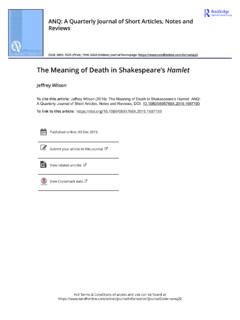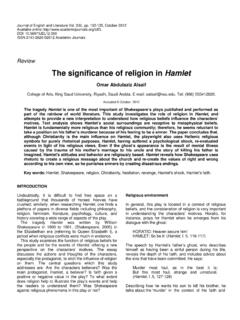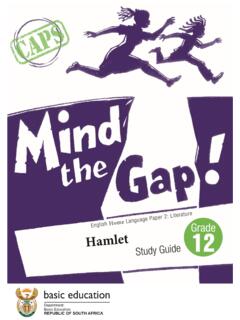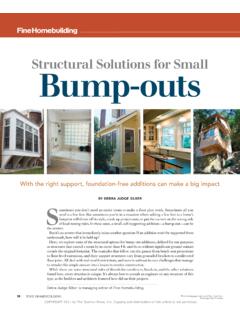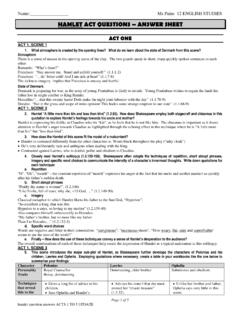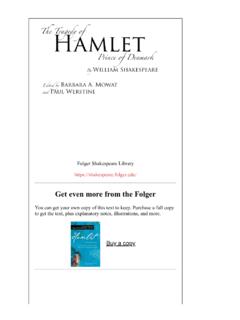Transcription of Hamlet Quick Study For Teachers - myShakespeare
1 myShakespeare 's Hamlet Curriculum Guide myShakespeare 's Hamlet Table of Contents Tips and Tricks for Teaching Hamlet .3. In-Class Activities and Ideas ..4. Act-by-Act Resources .7. Culminating Essays and Projects .13. 2. myShakespeare 's Hamlet Tips and Tricks for Teaching Hamlet In the Beginning . Poll the Class What do you know about Shakespeare? When did he live and what was his world like? What are some of the plays you have read or heard of? Have you seen any of Shakespeare's plays performed? Have you seen any film versions or adaptations of Shakespeare's plays ( Baz Luhrmann's Romeo + Juliet, 10 Things I Hate About You, etc.)? Have you ever performed anything written by Shakespeare? What do you know about Shakespeare's language?
2 Are iambic pentameter, prose, and verse familiar or unfamiliar terms? Do you know any famous quotes from Shakespeare? If so, what do you think they mean? What do you know about Hamlet ? Any famous lines? Plot points? Characters? Where is it set, and when? What are some themes of Hamlet ? What are your anxieties about Shakespeare? Is there anything that has confused you in past attempts to Study Shakespeare? Is there anything that you're dreading as you embark on Hamlet ? Play Around with the Text: A Sneaky Shakespeare Exercise Distribute the first 11 lines of dialogue in Hamlet to students. Work through the text as a class to unlock any unfamiliar phrases. Divide the class in half, into a "Team Bernardo" and "Team Francisco.
3 " Have students select from a pile of index cards listing "secret styles," such as horror, western, detective, opera, soap opera, sit-com, musical, farce, and so on. Have the class exchange dialogue in this style, either as a group or student-by-student down the line. Encourage students to go big this is Shakespeare! At the end of the exercise, re-group and have students guess Shakespeare's intended setting and style for the scene. Perform the scene in this style. Pre-Detecting: Interpreting Key Lines out of Context Distribute a worksheet of 5-8 key lines from Act 1 of Hamlet . Read each line aloud. Who do you imagine is speaking the line a man or woman, someone old or young, powerful or weak, good or evil?
4 Human or supernatural? To whom (or what) is he or she speaking? Have students write their ideas under each quote. 3. myShakespeare 's Hamlet Throughout the Play . Weird Word Log Select ten archaic or unusual words from your students' first reading assignment and have students guess meanings, first by the word alone, then by interpreting it in context. Have students create a Weird Word Log to keep track of unusual words as they continue to work through the play. For each word, students may wish to write a definition or synonym and write and illustrate a sentence of their own that employs the word. Character Bookmarks Distribute index cards to students, along with copies of the Dramatis Personae. Discuss the cast list with your students, with an eye towards relationships and social status.
5 Then have students depict the characters on their bookmarks based on what they've inferred from the Dramatis Personae. On the back, students can list character traits as they learn them, and continue to use these cards as a reference throughout the play. Remind your students that they can view the character blurbs for each scene, which might help them deduce what's important for each character as they move through the play. In-Class Activities and Ideas The following are brief overviews of general exercises that may enhance your students' experience. They can be adapted for use at any point in the play, depending on your curricular needs. Staging Hamlet As your students work through the play, ask them to generate ideas for staging the particular sections of the text you're reading.
6 Some reliably interesting moments include Claudius's speech to Denmark and Hamlet 's reaction Hamlet 's first soliloquy Hamlet 's encounter with the Ghost Hamlet 's To be or not to be soliloquy The Mousetrap performance Ophelia's madness The graveyard scene 4. myShakespeare 's Hamlet The duel between Hamlet and Laertes Once you've generated some ideas, show your students the corresponding scene from myShakespeare (at the links above). Use the following questions as a guide: Do certain staging ideas suggest different emphases? Different points of view? Different moods or atmospheres? What is conveyed by the staging ideas you have generated and by the film representation you have seen? Do you feel that some scenes can be dramatized more effectively through one medium or the other?
7 NOTE: This exercise can be easily expanded into a filmmaking or performance exercise using the same section of text (see Culminating Essays and Projects). You may also consider dramatizing moments that occur off-stage, such as the pirate attack, King Hamlet 's funeral, the Royal Wedding, and action that occurs after the play's conclusion. How Do Actors Convey Meaning and Tone? The following activity is adapted from Reading Shakespeare with Young Adults by Mary Ellen Dakin. Distribute copies of a famous speech from the play to students. Some suggestions include Hamlet 's soliloquies ( , , , , ). Polonius' advice to Laertes Claudius' O my offense is rank speech Ophelia's mad speech Gertrude's There is a willow grows aslant a brook speech First, have the students highlight words and phrases that appeal to any of the five senses sight, sound, smell, taste, or touch.
8 Then, have them underline and label examples of personification. Finally, ask your students to read the passage aloud. Once your students have completed these steps, discuss the following questions: How does the passage sound? Do you hear a rhythm? Are the words soft and musical, or harsh and discordant? What is the mood of this speech? how do the imagery and personification contribute to the mood? After the discussion, screen the corresponding myShakespeare scene (at the links above) for your students, asking them to keep in mind their earlier conclusions about the speech. Once they've viewed the scene, your students should discuss the following questions: 5. myShakespeare 's Hamlet How does the actor use his or her voice as a performance tool?
9 What kinds of choices in the sounds of their voices are the actors making, and how do those choices affect the meaning of the text? How else does the actor add meaning and emotion to the words? How does he or she use gestures, facial expressions, body language, and movement to enrich the words? How do the camera shots and angles contribute to the drama of the scene? You Be the Host With this exercise, your students will have the chance to step into Ralph's shoes. First have your students view a few examples of our character interviews for scenes they've already ready. Then, have them choose a scene that might make for an interesting interview. You might have them choose a scene that does not feature a myShakespeare interview, or to interview a character who doesn't get as much interview time in the hot seat.
10 Some options include Act 1, Scene 3 (Polonius Gives Advice). Act 4, Scenes 1-3. Horatio Rosencrantz and Guildenstern First, students should draft a set of questions to ask the character. They should consider How the character might be feeling in this scene? What does the character want at this point in the play? What might the character be hiding, and how can Ralph get them to reveal it? What thematic kinds of questions could Ralph ask to help a viewer better understand the play? Once your students have drafted scripts, the options are endless. They can stage a live interview for the class, film it studio-style, or even create podcast radio interviews. Musically Speaking Each act of myShakespeare 's Hamlet ends with a song summary.
